Inherent rate of sa node - Study guides, Class notes & Summaries
Looking for the best study guides, study notes and summaries about Inherent rate of sa node? On this page you'll find 94 study documents about Inherent rate of sa node.
Page 2 out of 94 results
Sort by
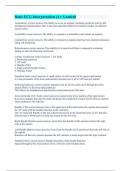
-
Basic ECG Interpretation (A+ Graded)
- Exam (elaborations) • 9 pages • 2024
-
- $10.89
- + learn more
Automaticity correct answers The ability to act as an impulse, initiating electrical activity and spontaneous depolarization (this is the most important difference between cardiac and skeletal muscle cells) Excitability correct answers The ability to respond to a stimulation and initiate an impulse Conductivity correct answers The ability to transmit an impulse that has been initiated and passes along cell membrane Refractoriness correct answers The inability of a muscle cell fiber to r...
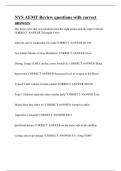
-
NYS AEMT Review questions with correct answers
- Exam (elaborations) • 7 pages • 2024
- Available in package deal
-
- $14.49
- + learn more
The heart valve that is located between the right atrium and the right ventricle CORRECT ANSWER Tricuspid Valve inherent rate of conduction SA node CORRECT ANSWER 60-100 Are infants Mouth or Nose Breathers? CORRECT ANSWER Nose During Triage of MCI cardiac arrest would be? CORRECT ANSWER Black hypoxemia CORRECT ANSWER decreased level of oxygen in the blood Typical Tidal volume of male patient CORRECT ANSWER 500 Ml Type 1 Diabetes typically takes insulin daily? CORRECT ANSWER Tru...
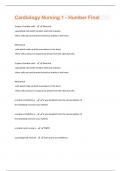
-
Cardiology Nursing 1 - Humber Final Questions And Answers Rated A+
- Exam (elaborations) • 53 pages • 2024
- Available in package deal
-
- $7.99
- + learn more
2 types of cardiac cells - Electrical -specialized cells which conduct electrical impulses -these cells start and transmit electrical activity in the heart Mechanical -cells which make up bulk musculature in the heart -these cells contract in response to stimuli from the electrical cells 2 types of cardiac cells - Electrical -specialized cells which conduct electrical impulses -these cells start and transmit electrical activity in the heart Mechanical -cells which make up bulk musculat...
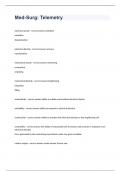
-
Med-Surg Telemetry questions and answers graded A+ 2023/2024
- Exam (elaborations) • 15 pages • 2023
- Available in package deal
-
- $17.99
- + learn more
Med-Surg Telemetryelectrical systole - correct answer activation excitation depolarization electrical diastole - correct answer recovery repolarization mechanical systole - correct answer shortening contraction emptying mechanical diastole - correct answer lengthening relaxation filling automaticity - correct answer ability to initiate and maintain electrical rhythm excitability - correct answer ability to respond to electrical stimulus conductivity - correct answ...
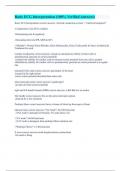
-
Basic ECG Interpretation (100% Verified Answers)
- Exam (elaborations) • 5 pages • 2024
-
- $10.29
- + learn more
Basic ECG Interpretation correct answers -Normal conduction system = *electrical impulses* -Components of an ECG complex -Determining rate & regularity -Measuring intervals (PR, QRS & QT) -*Identify*: Normal Sinus Rhythm, Sinus Bradycardia, Sinus Tachycardia & Sinus Arrythmia & Treatment for each Cardiac Conduction correct answers -based on automaticity( ability of heart cells to spontaneously generate an action potential) -conductivity (ability for cardiac cells to transmit acti...
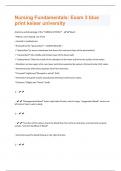
-
Nursing Fundamentals: Exam 3 blue print keiser university Exam Questions And Answers Already Graded A+
- Exam (elaborations) • 15 pages • 2023
- Available in package deal
-
- $7.99
- + learn more
Anatomy and physiology of the *CARDIAC SYSTEM:* - Heart: ▪ Hollow, cone-shaped, size of fist ▪ Located in mediastinum ▪ Enclosed by the *pericardium* = LAYERS INCLUDE = ▪ *epicardium* (a serous membrane that forms the innermost layer of the pericardium) ▪ *myocardium* (the middle and thickest layer of the heart wall) ▪ *endocardium* (lines the inside of the chambers of the heart and forms the surface of the valves ▪ Chambers are two upper atria, two lower ventricles separate...

-
Telemetry Rhythm (Exam 2)| Questions SOLVED with 100% Correct Answers
- Exam (elaborations) • 14 pages • 2024
-
- $11.49
- + learn more
What is repolarization? - period of rest, no electrical activity is occurring and a straight line is recorded on the EKG What is depolarization? - period of contraction Where is the SA node? What is it's inherent rate? - At the junction of the superior vena cava and right atrium, rate is 60-100 What is the rate of the AV node and what does it do? - Rate 40-60, control the number of impulses which reach the ventricles and prevents them from contracting before adequate filling occurs
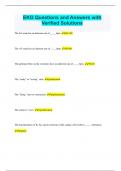
-
EKG Questions and Answers with Verified Solutions
- Exam (elaborations) • 11 pages • 2023
-
- $10.88
- + learn more
he SA node has an inherent rate of __-__bpm. 60-100 The AV node has an inherent rate of __-__bpm. 40-60 The perkinje fibers in the ventricles have an inherent rate of __-__bpm. 20-40 The "ready" or "resting" state. polarization The "firing" state or contraction. depolarization The return to "rest". repolarization The transportation of K, Na, and Ca into/out of the cardiac cell result in _____ formation. Impulse
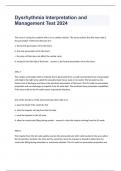
-
Dysrhythmia Interpretation and Management Test Questions and Answers 2024.
- Exam (elaborations) • 18 pages • 2024
-
Available in package deal
-
- $11.49
- + learn more
Dysrhythmia Interpretation and Management Test Questions and Answers 2024. The nurse is caring for a patient who is on a cardiac monitor. The nurse realizes that the sinus node is the pacemaker of the heart because it is: a. the fastest pacemaker cell in the heart. b. the only pacemaker cell in the heart. c. the only cell that does not affect the cardiac cycle. d. located in the left side of the heart. a. the fastest pacemaker cell in the heart. ANS: A The cardiac cycle begins with an ...
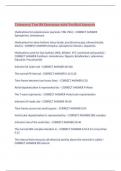
-
Telemetry Test 88 Questions with Verified Answers,100% CORRECT
- Exam (elaborations) • 8 pages • 2023
-
Available in package deal
-
- $11.49
- + learn more
Telemetry Test 88 Questions with Verified Answers Medications for pulselessness (asystole, Vfib, PEA): - CORRECT ANSWER Epinephrine, Amiodarone Medications for slow rhythms (sinus brady, junctional escape, idioventricular, blocks) - CORRECT ANSWER Atropine, epinephrine infusion, dopamine Medications used for fast rhythms (Afib, Aflutter, SVT, junctional tachycardia): - CORRECT ANSWER Cardizem, Amiodarone, Digoxin, Betablockers, adenosine, lidocaine, Procainamide Inherent SA node rate...

How did he do that? By selling his study resources on Stuvia. Try it yourself! Discover all about earning on Stuvia


